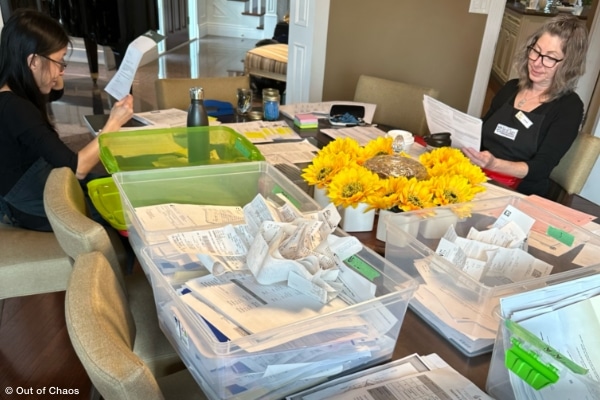
Recently, we worked with a client who needed help sorting paperwork. It’s a time-consuming job because you must read and interpret the information on the paper before deciding what to do with it. In fact, this client had several years’ worth of documents in piles, boxes, and filing cabinets around the home. We’re sharing the steps the Out of Chaos team took to help our client because our system may also help our readers.
Gather the Documents
First, bring all the documents to one central location. It could be a living room, spare bedroom, or basement. Choose an area with good lighting and adequate space to work comfortably without moving the documents if you want to take a break. For example, don’t use the dining table for sorting paperwork if your family eats there every evening. If you can’t bring everything to one room, get a few boxes at a time to work on. Remember, slow and steady progress is better than no progress at all.
Label Some Bins
Choose containers slightly larger than legal-sized paper. The Out of Chaos team uses clear bins for sorting paperwork because it is easy to see the contents. Of course, you can use whatever you have on hand. However, if you choose cardboard boxes, we suggest removing the top flaps or taping them down so that no one accidentally closes the box and puts it in the recycling bin.
Next, label the containers by year, starting with the current year and working backwards through time. If your document collection spans decades, we suggest labelling the most recent ten years individually. Then group the years in five- or ten-year time spans depending on the volume of paperwork.
Another key point when sorting paperwork is to have a uniquely coloured bin for vital and other important records such as birth certificates, wills, etc. You can see in the image above our team is using the green container for that purpose. If you use cardboard boxes, add some paint, marker, or colourful tape to make your “vitals” box stand out.
Designate Waste Bins
To make your process more efficient, have bins for recycling and trash within arms’ reach. The Out of Chaos team uses clear, blue bags, so we do not mix up recycling/trash with the bins of paperwork we need to keep.
The First Pass Sort
Sorting is straightforward but tedious. Remove papers from envelopes (if necessary). Unfold them and place them in the box for the appropriate year. If you are sorting through piles of papers, separate them to ensure you find any small slips that may be stuck between them. Occasionally something small like a receipt or wallet-sized birth certificate could be trapped between financial statements. Likewise, always thoroughly check inside envelopes and folders.
Detailed Sorting Year by Year
Once you have sorted all your documents by year, you can begin sorting paperwork within each year. Begin with the most current year and work backwards through time because you’ll likely need to access more recent documents frequently. Organize and file the paperwork using our guide or the FreedomFiler® system. If you are unsure what to keep, we suggest you seek legal and financial advice, as everyone’s situation differs.
Disposal
You should shred documents containing sensitive information, such as anything with an account number (bank statements, insurance policies, employee pay stubs, void cheques, etc.). Also, shred anything that includes passwords, PINs, signatures, or other data that someone could use to steal your identity. To protect your privacy, consider shredding documents which include your name, address, phone number or email address.
A small cross-cut shredder will likely do the job if you only have a small stack of documents. And it would be best if you had one handy to help you maintain a tidy filing cabinet. However, shredding paperwork can be time-consuming if you have more than a box or two. In that case, contact a shredding company to arrange a drop-off or pick-up.
Choosing a Shredding Company
When searching for a shredding company, choose one that is industry compliant. They should be NAID AAA Certified to ensure your confidential information is secure from the moment they receive it to the point where they shred and recycle it.
To become NAID AAA Certified, shredding companies must meet strict ethical standards and complete thorough background checks on all employees. The shredding company should also provide you with a certificate of destruction. Finally, ask about how the company handles their waste. Ideally, they should send the paper shreds to the recycling stream rather than the landfill. To help our readers, we’ve included a list of local NAID AAA Certified shredding services on our Resources page.
Remember, if sorting paperwork feels overwhelming, the Out of Chaos team can help. Contact us today to book a consultation.
